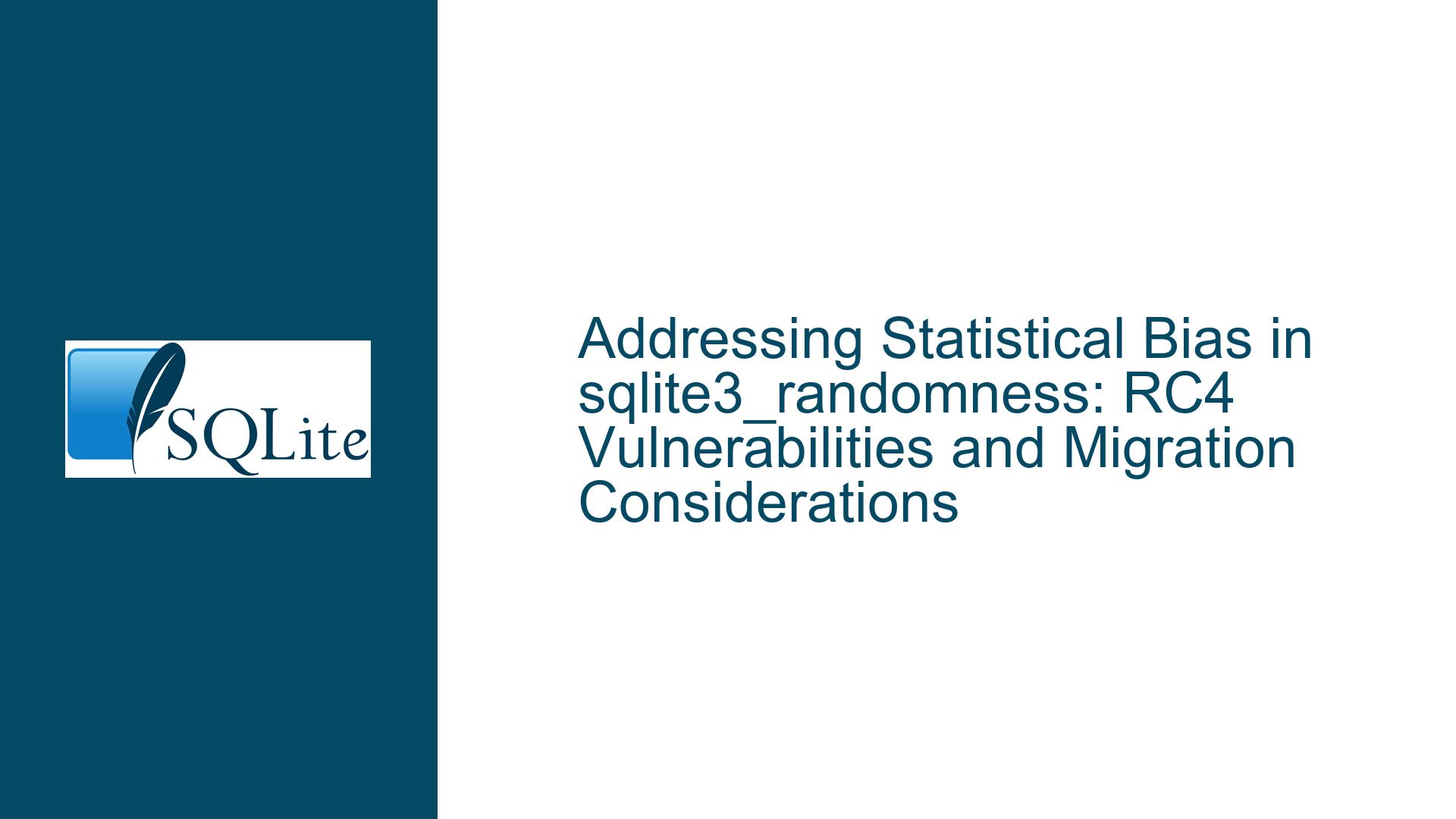Addressing Statistical Bias in sqlite3_randomness: RC4 Vulnerabilities and Migration Considerations
RC4 Algorithm Limitations in sqlite3_randomness and Implications for PRNG Reliability
The sqlite3_randomness function in SQLite is designed to generate pseudo-random numbers for internal operations such as temporary file naming, query plan optimization, and other non-cryptographic use cases. Its reliance on the RC4 algorithm (also known as ARC4) has raised concerns due to documented statistical biases in RC4’s output stream. Research from cryptographic communities, including analyses in Selected Areas in Cryptography (SAC 2010), highlights vulnerabilities in RC4’s keystream generation, such as non-uniform byte distribution and susceptibility to distinguisher attacks. These flaws compromise the quality of randomness even in non-security contexts, potentially affecting SQLite’s internal operations that depend on unbiased entropy.
The core issue revolves around RC4’s outdated design, which fails to meet modern statistical standards for randomness. For example, RC4 exhibits biases in the initial bytes of its output (the "Fluhrer-McGrew" bias) and long-term correlations in its keystream. These weaknesses make it trivial for adversaries or even benign statistical analyses to predict portions of the output, undermining the integrity of applications that assume uniform randomness. While SQLite’s documentation explicitly states that sqlite3_randomness is not intended for cryptographic purposes, the presence of statistically biased outputs could still lead to unintended consequences in scenarios like hash table collisions or randomized query optimization.
The discussion around migrating to alternatives like ChaCha8/12/20 stems from their proven resistance to statistical biases and improved performance on modern hardware. Unlike RC4, which relies on a simple permutation-based state machine, ChaCha employs a cryptographically secure design with diffusion layers and bitwise operations that eliminate measurable biases. The urgency of addressing this issue is amplified by precedents in other projects (e.g., OpenBSD, FreeBSD) that abandoned RC4 in favor of ChaCha due to similar concerns.
Root Causes of RC4’s Continued Use and Performance Trade-offs
The persistence of RC4 in SQLite’s sqlite3_randomness implementation can be attributed to historical inertia, minimal performance overhead on legacy systems, and a lack of immediate security requirements for its use cases. RC4’s simplicity—requiring only a 256-byte state array and basic swap operations—made it an attractive choice for early SQLite versions targeting resource-constrained environments. However, advancements in CPU architectures and the proliferation of 64-bit/ARM systems have rendered these advantages obsolete.
One critical oversight is the assumption that non-cryptographic PRNGs need not guard against statistical biases. While SQLite does not use sqlite3_randomness for encryption, biases in the generated numbers can still affect database operations. For instance, skewed distributions in temporary object identifiers might increase collision rates, leading to degraded performance in edge cases. Furthermore, RC4’s initialization phase (key scheduling) is prone to weak key patterns, which can exacerbate bias issues if the seeding mechanism is insufficiently robust.
Performance considerations also play a role. RC4’s single-byte-at-a-time output generation is inherently serialized, limiting throughput on modern CPUs with parallel execution capabilities. In contrast, ChaCha’s block-oriented design can leverage SIMD (Single Instruction, Multiple Data) instructions and pipeline-friendly operations, offering higher throughput on 32-bit and 64-bit architectures. ARM processors, which dominate mobile and embedded markets, benefit particularly from ChaCha’s alignment with 32-bit word operations, a natural fit for their instruction sets.
Mitigating RC4 Bias: Evaluation, Migration Strategies, and Benchmarking
To resolve the statistical bias in sqlite3_randomness, a systematic migration from RC4 to a modern PRNG like ChaCha is warranted. This process involves three phases: algorithm evaluation, implementation testing, and performance benchmarking.
Algorithm Evaluation
ChaCha8, ChaCha12, and ChaCha20 are variants of the ChaCha stream cipher, differentiated by their round counts (8, 12, and 20, respectively). ChaCha8 provides a balance between speed and security, making it suitable for PRNG applications. Its structure—a 64-byte state matrix processed through quarter-round operations—ensures rapid diffusion of entropy, eliminating biases detectable in RC4.
Implementation Testing
Replacing RC4 with ChaCha requires modifying SQLite’s sqlite3_randomness function to use ChaCha’s keystream generation. The ChaCha state must be initialized with a 256-bit key and 64-bit nonce, derived from the operating system’s entropy source (e.g., /dev/urandom on Unix-like systems). Care must be taken to preserve thread safety and avoid introducing side channels during state updates.
Performance Benchmarking
ChaCha’s performance advantages become evident on CPUs with 32-bit or 64-bit ALUs (Arithmetic Logic Units). For example, a single ChaCha block generates 64 bytes of output in parallel, whereas RC4 produces 1 byte per operation. On an ARM Cortex-A72 processor, ChaCha8 can outperform RC4 by 3–5× due to efficient use of pipeline stages and reduced dependency stalls. x86_64 systems with AVX2 vector instructions can further accelerate ChaCha via SIMD parallelism.
Migration Steps
- Deprecate RC4 in SQLite’s codebase by replacing the existing PRNG logic with ChaCha8.
- Integrate compile-time flags to allow users to revert to RC4 for backward compatibility.
- Update documentation to reflect the improved statistical guarantees of the new PRNG.
Validation
Post-migration testing must include statistical test suites (e.g., TestU01, PractRand) to verify the absence of biases. Comparative benchmarks should measure throughput and latency across architectures to confirm performance gains.
By adopting ChaCha, SQLite would align itself with industry best practices, eliminate RC4’s statistical weaknesses, and leverage modern CPU capabilities for faster, more reliable randomness generation.






